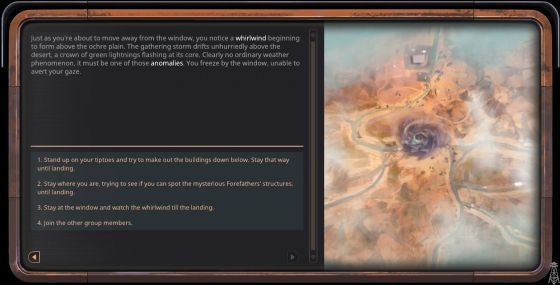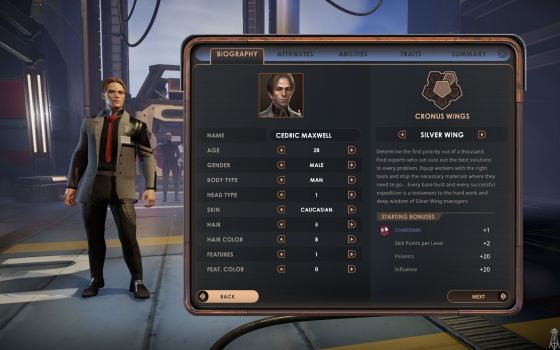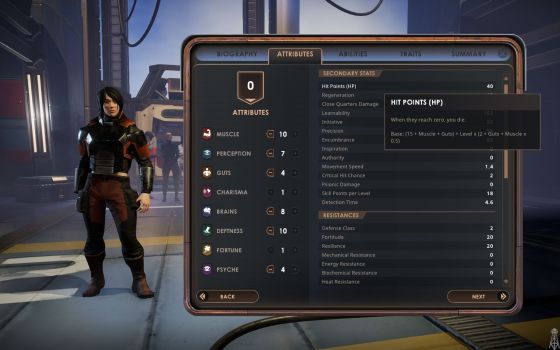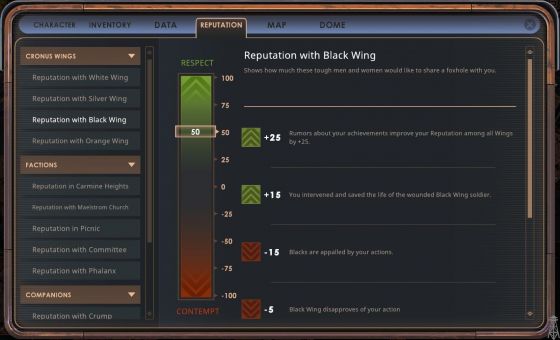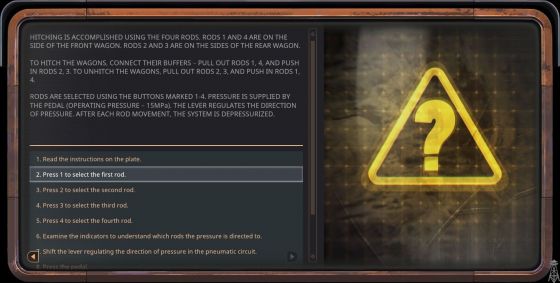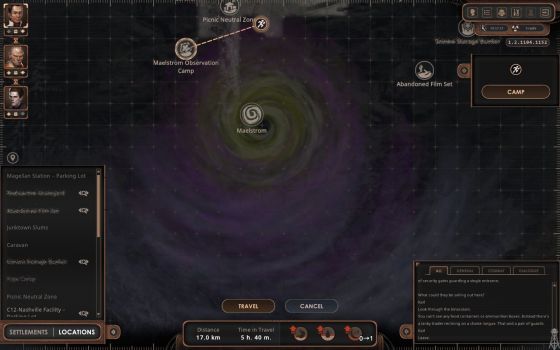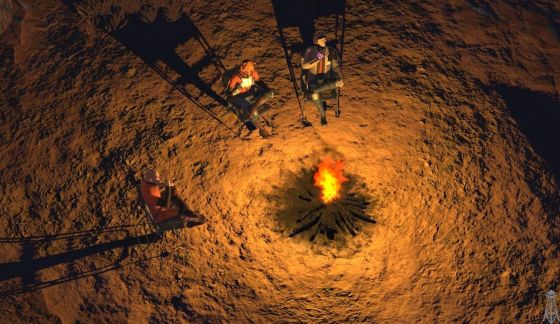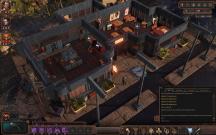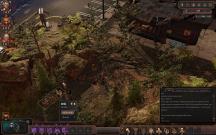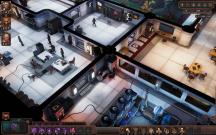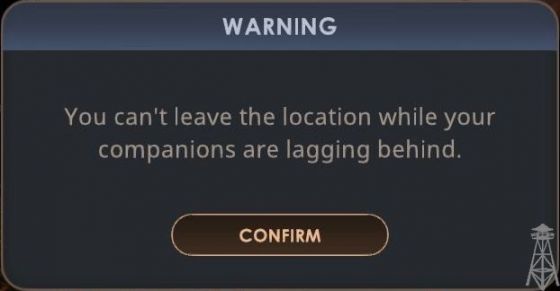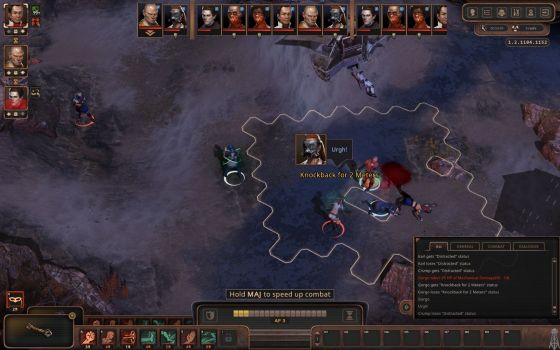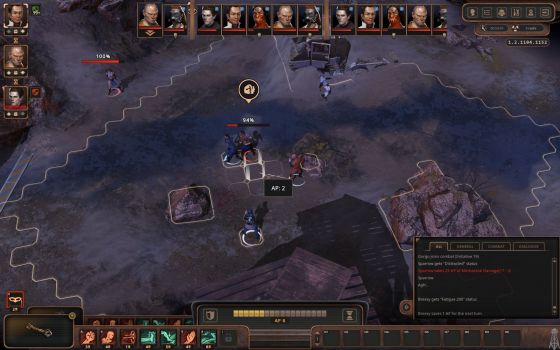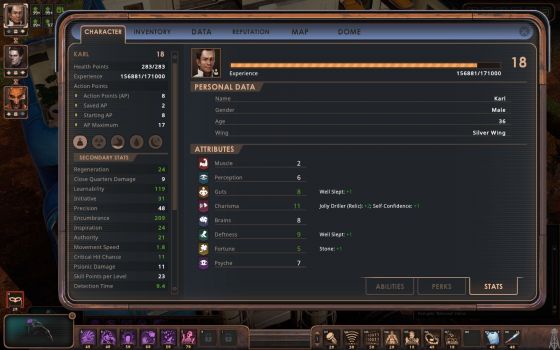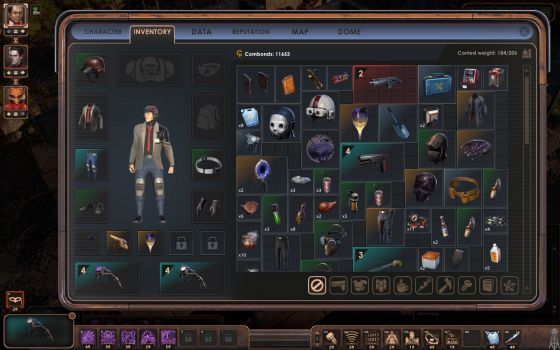Encased: A Sci-Fi Post-Apocalyptic RPG Review

Introduction
Quick facts:
- story-driven "isometric" RPG, single-player only
- small/medium areas and world map
- turn-based combat with action points
- party with 2 companions, sometimes extra temporary ones
- no race choice, 5 classes called "wings"
- factions, reputation, crafting
- 50-60 hours, more for completionists
- multiple endings, medium/good replay value
Encased was developed by Dark Crystal Games after a successful Kickstarter campaign which started in September 2018. Dark Crystal Games is an independent video games company started in late 2017 in Saint-Petersburg, Russia. The publisher was initially Black Tower Entertainment, but they announced in December 2020 that they would partner with Prime Matter (a spin-off of Koch Media), which allowed them to spend more time to develop the game and add extra features from stretch goals that had not been reached during the campaign. The game was released in September 2021, after a long Early Access.
Setting and Lore
Encased is set in an alternate retro-futuristic '70s era. The game takes place inside a giant Dome that has been built by a mysterious, more advanced civilization called the Forefathers, and which has been recently discovered in a remote desert. CRONUS, a company founded by governments for that purpose, has sent people inside the Dome to explore and assess the situation. There, they found new technologies and strange artefacts left by the Forefather. More people were sent, they built facilities and brought more equipment inside the Dome to recover these artefacts and try to understand their technology. The player is one of the new arrivals.
The Dome is also the host to the Maelstrom, which has a life of its own and reacts to the human presence by spawning anomalies, and triggering other events that will quickly escalate to a potential disaster. As a little caveat in the contract, the journey to the Dome is a one-way trip for living creatures! Since the explorers cannot come back, they can only face those events in order to preserve the settlements and survive.
The story is sound and relatively simple; you will not find overly convoluted plots and extensive lore in Encased. Yet it is original and doesn't follow the usual post-apocalyptic nuclear scenario of many other games. The difference can be felt when the player explores the areas too: it is not a desolated environment but a mix of modern facilities, countryside settlements and a few areas that have been devastated by a cataclysm.
For a game of this size, I felt that the setting and the background history were very appropriate. I especially enjoyed the variation on the traditional post-apocalyptic theme, which allowed for more variety in the environment and gameplay.
Story and Storytelling
The story is mainly told through dialogues with the NPCs and vignettes; it is composed of a prologue, 3 acts and an epilogue.
The beginning is quite interesting with the player discovering a new environment, receiving training and learning how the different factions work together in this confined world, which is not exempt of a few political and power struggles. Once the player is familiar with all that, the prologue quickly leads to a chain of events that re-orient the story and give a clear purpose. This is a classic and proven approach.
The first acts continue to bring new developments to the story, and more locations to discover and explore. But from that point it slowly begins to stall. The story keeps feeding the quest lines with tasks to keep the player engaged, but I felt that it became more predictable and less substantial. I could have enjoyed a few more surprises, instead of settling into a series of logical tasks to follow.
The companions are another missed opportunity: they have a personality and they are quite original, but they are also very shallow. Sure, it is possible to discuss with them, to get to know them better once the player gets enough reputation with each of them, and it is even possible to ask their opinion on factions and other companions. But it remains very limited and does not really progress further with the story.
On the other hand, each NPC in the game has its own dialogue tree, and it is often engaging to discuss with them. The dialogues are not very long, but they often offer multiple branches and difficulty checks, like for example some lines being limited to a specific wing for a very technical conversation. And those dialogues are not limited to the NPCs who are involved in the main quest, or even any quest; they are just eager to share their thoughts or to talk you through some task when needed.
The vignettes are another nice way to tell a part of the story, a conversation or a particular event with a few pages of text illustrated by pictures, and sometimes sound effects. The NPC dialogues, like the vignettes, may include a narrative to better describe what is happening, without ever being text-heavy.
For me, Encased has reached just the right balance of content between story, exploration, quest and combat. And in the story, it keeps a good balance between the varied ways to convey it. I was not really frustrated by its lower development in the last acts, but I wish they had maintained the same rhythm throughout the whole game. It feels as if they had a good inspiration but didn't have the time to flesh it out as much as intended in the late acts.
Character Creation and Development
The adventure begins with the character creation. The player can either design it from scratch or select one of the pre-made characters, and optionally modify them.
Each character has 8 base attributes: Muscle, Perception, Guts, Charisma, Brains, Deftness, Fortune and Psyche. Then, there are 5 wings to choose from, which define the job specialization. In practice, they give a boost to the relevant attributes at the start of the game, and open specific dialogue lines, but choosing the wing won't close any door. For example, a white wing (scientist) can acquire lock picking or heavy weapon skills. Finally, an optional character trait gives a permanent bonus / malus.
The character progresses at each level by earning skill points, that the player distributes among the skills, opening up new tiers and granting abilities, for instance such as First Aid, Point-Blank Shot, Charm, Lock picking. There are 7 combat skills (Light/Heavy/High-Tech/Melee Weapons, Contraptions, Psionics and Hand-to-Hand) and 7 "applied" skills (Piloting, Medicine, Tech, Science, Criminal, Influence and Survival), so plenty of ways to orient one's career! Every 3 levels, the player also earns a new perk, which modifies stats and gives a little boost.
There is a lot to take in, and while the interface does a very good job by providing the details of each parameter, it is not always easy to understand how useful they are, not before playing for a while anyway. But as much could be said of any RPG, this is part of the discovery.
A more delicate issue is balancing; at some point in the Early Access I could easily create a Jack-of-all-trades from the start, who could make his way as efficiently by charming, shooting or hiding. A new update made that more difficult, but on the other hand I feel too easily trapped in very specialized career paths. The full release refined the balance further and the result is much better but only for the first part of the game, after which I found that the player could get enough skill tiers to be proficient in many trades, making it too easy - I played on "classic", which only leaves one higher difficulty setting.
The game is well made enough to provide the player with multiple options in most situations, and that's a strong design point. But the character development should rely more on that asset to constrain a more specialized path, and I hope the next tuning phase goes that way. It would definitely be more interesting and increase the replay value.
Quests
The main quest is well developed, especially in the first half of the game. The first quests you receive in the Concord welcoming facility are a sequence of simple tasks that are only meant as a tutorial for the main skills. It is more a preamble to the game than part of the main quest, yet it fits perfectly into the story of a newcomer getting some training for a new job. This is a short phase and you are relatively free to tackle those tasks in any order, or to bypass them almost completely.
Once you are ready, you leave that first area and the real exploration begins! There are some elements of surprise in the main quest, but not many. Thankfully, it is not linear; the sub-quests are divided into multiple branches in each act, and once again you are free to choose what to take next. Since it generally involves different locations that are distant on the map or require a certain level, you can try and optimize your journey to get most of the game. Or you can decide to follow the predilection of the moment: discovering something new, revisiting a location where you were stranded before, or getting back to an NPC for the reward of a quest...
Many quests can be solved by different ways, too. And some have multiple outcomes with different advantages. The choices you make don't have a significant impact on the story and the main quest line, but they usually have an impact on your reputation with the factions and the companions. At the end of the game, you will also realize that some of those choices were important for the final outcome and the future of the Dome.
The companion quests are almost non-existent, which exacerbates the impression of shallowness regarding the few companions. As for the side quests, some are simple fetch quests but others are original or closely related to the main story. I didn't have the feeling any of them was just filler content; on the contrary, they are often fun to do and participate to the general caricature of the world that the game is fond of depicting.
To illustrate the variety of quests, in a classic one I could double-play two parties involved in a shady undertaking that I discovered by eavesdropping on a conversation. I must say it was very satisfying; I even took the time to replay this quest to find all the possible outcomes. In another quest, I had to face the bureaucracy to be admitted somewhere, filling forms, listening to all the rules ... and taking a short exam to prove I was actually paying attention! I found a couple of other quests presented as mini-games, for instance a small interactive adventure on a terminal and a video game described by text.
Be reassured, there are no timed quests! Well, except the first one you receive at the welcoming facility, which isn't a concern at all. A few tasks require you to be at some place on a specific time of the day though - yes, there is a day/night cycle and you need to drink, feed and rest or suffer penalties. So time matters to a little extent, since resources are not infinite, but I have never felt under pressure to hurry up or give up on the content because of time.
Exploration
The world of Encased is composed of local maps and a travel world map. There are 50+ locations, small and big, that I could see on the world map at the end of the game; they are only visible once you discover them or if you are told by someone else, for example in the scope of a quest. Travelling takes time in the game, which means you get hungry, thirsty and tired. Fortunately, you can set camp at any moment and access a shared stash of looted items to get a nice diner before sleeping.
The locations are small to medium, like other similar games. The faction settlements and CRONUS facilities are the largest. Some have several areas that are interconnected, like for example floors accessible by a lift. Others are made of independent houses or shacks that are sprawled over the area. The environment is somewhat varied: "retro-futuristic" buildings, junk towns, desert camps, abandoned bunkers, swamps... but the dominant theme is a mix of modern buildings and desert camps.
The larger settlements are populated with a satisfying number of NPCs, objects to find, and places to explore. They feel alive, even if many NPCs tend to remain on their spot. But this is only true for the first part of the game, mostly. Settlements that are discovered later, usually owned by new factions, may have a similar number of NPCs but little conversation and very few quests. So once again it feels as if the developers have been busy bringing life into the first part of the game, but couldn't sustain the same cadence in the later acts.
The level of detail and the care taken to design the locations remains relatively constant, however. The graphics, the variety of objects and textures are convincing, and some environment sounds are quite good too. Unfortunately, a few sounds are played in endless loops, like two public announcements you will often hear (and get to hate) in ex-CRONUS facilities, some TV shows, or a very few NPCs.
Another notable quality of the exploration is the multiple paths that are often available to reach a place, or the multiple ways to interact with items by using different skills. In buildings, you can find hidden ventilation passages to locked or guarded rooms, but you can also use stealth and lock-pick the door. Or you can blast everyone and try to force the door. Sometimes you can get the help of an NPC to get access, or steal their pass. But careful with the criminal approaches, because NPCs will notice when something is off, and may become hostile or call for help. You may even get imprisoned for a few days - and try to escape if you don't want to wait, or if that's just who you are.
There are a number of objects that can be interacted with. Some are basic like doors, decorative lamps, phones, lifts, containers to loot; others are more complex and sometimes part of a puzzle like computers, security monitors, hydraulic valves or items to repair. Some skills allow to interact differently with those items (hacking, tech skill to repair, and so on). Again, there was visibly more effort in the earlier locations, where computers can be searched for information, or control more complex mechanisms that need fixing or unlocking, whereas in the later locations, most of them are just decorative and just indicate that they are locked.
The most annoying part of exploration is the poor pathfinding system. The companions are not very much aware of their surroundings: sometimes they avoid mines and hazardous areas but not always. Fortunately it is possible to control each companion separately, and even to interact with the inventory and the environment with the companion's abilities and actions. Also, companions tend to lag behind, and you'll often get an invitation to wait for them when leaving a location. To be fair, there has been a huge improvement in that area since Early Access, so we can reasonably hope that they will continue improving those little quirks.
Combat
Encased includes all the necessary ingredients for an engaging combat but it still needs a phase of tuning.
The combat involves your party and possibly friendly NPCs against the enemies in a turn-based mode with action points. You have full control of your companions but the other NPCs act on their own. There are seven combat styles: light, heavy, melee and high-tech weapons, hand-to-hand, contraptions and psionics. The proficiency is obtained through the corresponding skills, each tier giving you additional combat abilities. There are multiple and varied weapons in each combat style and, what is even better, you can craft upgrades for them.
There are several problems, however. Overall, the AI is not brilliant and the fights are easy to win. The enemy AI being average is not a big problem, but sometimes friendly NPCs are silly and draw friendly fire with grenades and area-of-effect weapons.
Then, there is little incentive to use more than the base ability of each weapon, because the higher abilities require a cooldown or are very costly in action points for the advantage they provide. And since it is fairly easy to unlock tiers in multiple combat styles, there is no real need to build a strategy with the other companions, except maybe raw power support when you face more dangerous foes.
To give an example, the hand-to-hand combat lets you hurt the adversary, which is the basic ability - a good old-fashioned punch, but it also allows you to stun or exhaust them with special kicks. Other styles can take advantage of those conditions, so it wouldn't be hard to imagine interesting combinations between companions. But it just feels unnecessary, and most players will rather preserve the action points just in case, and use the default punch which is already quite effective.
At the exception of the AI limitation, those problems would only require a proper tuning of the ruleset, so I'm hoping that the patch #4 planned for early 2022 will improve the situation. This hasn't ruined my experience because it's not that bad and I'm interested in other gameplay features too, but it could be a problem for someone looking forward to challenging fights.
Presentation
The game's presentation is excellent for its scope, I would even say it has little to envy to non-indie games.
User Interface
The user interface is clean and provides all the necessary details so that you can understand the underlying mechanics and the choices you make. For example, each stats-related parameter has a tooltip showing how it is used or how it is calculated.
Since the ruleset has many secondary stats, the developers could have gone a little further and highlight the stats impacted by the main attributes when hovering or changing them. Each time I create a new character, it is an iterative process to get those attributes right and it would help to directly see the changes made when incrementing Deftness or Guts, for example.
The UI theme is a little on the brownish side, but it fits the setting perfectly. The choice of fonts and colours make the text very easy to read and not straining to the eye.
The "chat panel" which is used during the conversation occupies a big part of the lower screen. It is easy to select the dialogue options and to scroll back to its beginning in case something was missed. However, the panel hides the notifications which appear behind it when a new quest is triggered or when items are received during a conversation, which leaves the player guessing about those. The journal is clear enough and highlights new quests, so this is not a big issue, but the inventory does not, nor does it help much when it comes to looking for an item.
The inventory has the necessary filters and compares items with the current equipment. It splits in two when bartering with a merchant or another NPC, allowing a comparison. The item icons are well-drawn and there is no ambiguity about what they represent; a tooltip shows the details simply by hovering with the mouse cursor. My only reproach is the messy look, which is usual in inventories but made worse in this case by having items of different sizes like in ATOM RPG, but it's mostly nit-picking on my part.
Graphics
The graphics are very well made and give the impression of a solid, polished game.
The locations are crafted with care. Each contains many objects of all sorts, which are relevant to the environment, match the retro-futuristic theme, and are very well designed.
The characters are fine, except the hair parts that look as if they were made of plastic. Characters are not meant to be seen up close anyway, so it has never bothered me. Characters are varied to some extent, mainly the outfits, the skin colours and the faces; I have not seen variations in shape. Their animation look natural, even if sometimes the character is standing too far from the object he/she interacts with (it is quite visible when lock-picking, for instance).
There is a night/day cycle which is visible by the changing light in the game. There are some light, haze and other effects which make the game looks very good, but there is nothing too fancy either.
I never had any performance issue, even with all settings on maximum and the game running an old system (i7 4770, GTX 980).
Voice Acting, Music and Sounds
In my opinion, the voice acting is very good, including the narrator. It is only partial, there are more voiced dialogues at the beginning, and later mostly for the main quest but not always - there seems to be small incoherencies in what is voiced or not now and then.
The music is fine but not remarkable. In some areas like Roadside Picnic, it can even get a little repetitive and monotone after a while, though I'm not sure another choice of music would do much better. It fits the theme and the atmosphere of the game, after all, and when I found it repetitive, it was often because I had been exploring the same area for a long time. It never got on my nerves, anyway.
As mentioned previously, the sounds have a good and convincing quality to them. When you click on a coffee machine, when you type on a keyboard, or when you trash a locked door, you hear what you would expect to hear in a real situation (I suppose anyway, I never had to trash doors). Each weapon has its distinctive signature too.
Conclusion
Despite several good releases this year, Encased is one of my very few favourites. It does not have the depth and breadth of other games made by larger teams, but it has ambition, character, and it is very enjoyable.
This game begs you to try different options and have fun doing it. You can try to achieve an objective by the book, or by using stealth, or by killing everyone in your way. You can do it alone or with companions. And even if you mess up, you know that the game will not punish you too hard - who knows, it may even reward you for it! It is also in great part about fun, because even though you cannot exit the Dome, even though you witnessed a cataclysm and a lunatic maelstrom is threatening to wipe everything out... well, people around you still live on, and society is depicted as a cliché that you can exploit, laugh at or be part of.
The developers have pushed the outside of the envelope in some directions, trying to give choices, numerous dialogues, varied quests and exploration, but the price to pay is uneven depth in many of those elements. It feels a little bit as if they threw everything they had in the first half of the game, got worn out and couldn't keep quite the same standard until the end. The base is very strong though; even if the mechanics need tuning, the skill system is sound, and the UI, the graphics and the locations are well crafted.
Dark Crystal Games is still working on Encased. The two next major patches will flesh out the content (patch #3) and tune the game mechanics (patch #4), so hopefully they will cover most of these little shortcomings.
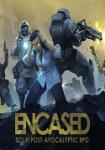
Information about
EncasedDeveloper: Dark Crystal Games
SP/MP: Single-player
Setting: Post-Apoc
Genre: RPG
Combat: Turn-based
Play-time: 40-60 hours
Voice-acting: Partially voiced
Regions & platforms
Internet
· Homepage
· Platform: PC
· Released: 2021-09-07
· Publisher: Prime Matter
More information
Other articles
Summary
Pros
- Good balance of story, quest, exploration and combat
- Variety of quests and dialogues
- Multiple approaches in quests, exploration, dialogues
- Design of locations, setting theme
- UI and game presentation
Cons
- Decreased content in the 2nd half
- Overall difficulty tuning (too easy)
- Shallow companions
- Poor AI / pathfinding




